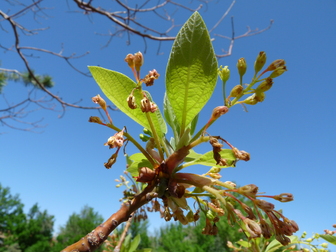Back to Tour: Medicinal Plants Tour
|
Sassafras albidum Sassafras |
Denver Botanic Gardens
Gardens Navigator 
|
|
Accession Number: 861361*2 Map | Image | |
| More about Sassafras albidum | |
| TOUR DETAILS |
Medicinal uses: Medicinally, sassafras has been found to be an aromatic, stimulant, diaphoretic (causing sweating), depurative (something that purifies), febrifuge (reducing fever) and diuretic. It also has antiseptic and antitoxic properties, being used as an antidote in cases of lead, arsenic, tobacco, henbane and lobelia poisonings. The oil coming from the leaves has been known to help ease menstrual pain. However, in the 1960’s the oil was found to contain safrole, which is carcinogenic in the body. Thankfully the leaves of sassafras have safe levels of safrole to be eaten. The oil has been found to contain similar compounds to ecstasy and can have the same long-term side effects in cases of long term consumption. Mythology/Folklore: Sassafras is native to North America, and has a long history in Native American medicine. The Cherokee tribes first used sassafras tea to purify the blood, and heal wounds. Once the colonies were established, the plant became the first major forest product shipped to the “Old World.” In fact, it was so popular in the “Old World” that at the height of the “Sassafras Craze,” colonists were burdened with a governmental requirement that each man produce 100 pounds of sassafras per year or be penalized 10 pounds of tobacco. Medicinal recipe: Homemade Root Beer Syrup: Ingredients: 6 cups water, 3 ounces sassafras roots, 1 ounce burdock or dandelion root, 1/4 cup molasses, 1 clove, 1 star anise, 1 teaspoon coriander seeds, 2 drops wintergreen or peppermint extract, 6 cups sugar Instructions: Chop the sassafras and burdock roots into small pieces, about 1/2 inch or smaller. Put the roots in a medium-sized heavy pot with the clove, star anise and coriander seeds and cover with the water. Cover the pot and bring it to a boil. Simmer this for 15 minutes. Add the molasses and simmer another 5 minutes. Turn off the heat and add the wintergreen or peppermint extract. Put the cover back on. When the mixture cools, strain it though cheesecloth. Return it to the pot with an equal amount of sugar. Stir to combine. Bring it to a simmer and cook it for 5 minutes, uncovered. Pour into quart mason jars and seal. Keeps a year in the fridge. Culture: (from Angie Andrade, staff senior horticulturist) Sassafras is grown as a small tree or multi-stemmed shrub. Our tree |
| LOCATION GROUP | Sensory Garden |
| FAMILY NAME | Laurel; Medang Family |
| FAMILY | Lauraceae |
| ACCESSION DATE |
June 19, 1986 (When this plant was acquired and registered in the database) |
| DATE LAST MEASURED | February 22, 2011 |
| HEIGHT (FEET) | 15 |
| SPREAD (FEET) | 14.5 |
| TRUNK DIAM. (INCHES) | 13 |
| FLOWER COLOR | green |
| FLOWER COLOR NOTE | greenish-yellow |
| FRUIT COLOR | blue |
| USDA HZ | 4 (Coldest Zone Where Hardy) |
| HABIT | Tree |
| SOIL | dry, sandy |
Location Map for 861361*2 Sassafras albidum
Map Help
Images © Denver Botanic Gardens
 861361*2 Sassafras albidum Flower|Fruit|Leaf |

© Denver Botanic Gardens, 1007 York Street, Denver, CO 80206
Photography © Denver Botanic Gardens

Powered by







 E-mail
E-mail